by Stephanie Fox
The Smithsonian Environmental Research Center (SERC) celebrated Earth Day with the first trash audit since changing its recycling system.
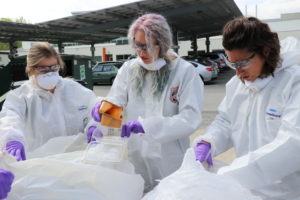
SERC administration staff Sarah Wade, Michelle Rossman and Lauren Nicol sort through trash bags in search of recyclables. (Photo: Stephanie Fox/Northwestern University)
After examining almost 115 pounds of waste and recycling bags, the SERC operations team in charge of today’s audit found only about 3% of items were thrown in the wrong bin. That’s a huge improvement from the first audit that took place in the fall.
SERC prides itself on being one of the most environmentally friendly research centers in the country. Its Mathias Laboratory was awarded a “Platinum” Leadership in Energy and Environmental Design (LEED) certification, the highest rank LEED offers for green buildings. It also received the President’s GreenGov Building the Future Award in 2015, awarded to buildings with sustainable operations and green designs.
That’s why members of the staff were shocked to find that a 2018 waste audit revealed them to be terrible at recycling.
“We wanted to revamp our recycling efforts here at SERC, so part of that was seeing what was happening. How was our recycling program that was in place working?” explained SERC’s Zone Manager Andy Smith, describing the waste audit that took place in October 2018. “We found that we were doing pretty poorly, to be honest.”
The primary culprit of bad recycling was cross contamination—when a non-recyclable item or container damaged with food waste is placed into a recycling bin.
The Smithsonian-wide contractor that oversees waste and recycling removal is effective for most of the Smithsonian’s buildings, which are within D.C. city limits. But the SERC campus is about 50 minutes away in Anne Arundel County, Maryland. The 54-year-old research center sits on the edge of Chesapeake Bay, simplifying the commute of scientists doing environmental research. The research center’s location makes scientist’s lives easier, but made it impossible for the contractor to remove waste from the facility. Instead, the company subbed the location to a local waste removal company that does business within Anne Arundel County.
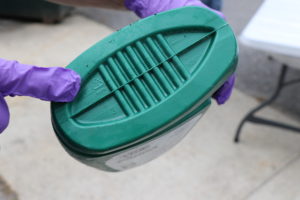
Only plastics labeled 1 or 2 can be recycled at SERC. (Photo: Stephanie Fox/Northwestern University)
Unlike the D.C. recycling facilities, which encourage the separation of various recyclable items, Anne Arundel County facilities do a single-stream pick up, which allows residents to place any and all recyclables into the same blue waste container. This may seem like a more efficient way of recycling, but it actually means that most people who think they’re recycling are sending an entire container full of recyclables to a landfill.
“If someone drops a soda bottle in the paper bin for some reason and it contaminates the paper… it just gets thrown away as waste. If in our bottles and cans there are food products or other non-recyclable items, then that can’t be recycled and it has to be thrown away as trash,” Smith said. “Anything more than 5% contamination we have to throw away as trash.”
The October audit was conducted by the SERC operations staff, the SERC sustainability committee, and the Smithsonian Institution’s Eric Hollinger. An anthropologist at the Smithsonian’s National Museum of Natural History, Hollinger spends his free time elbow-deep in trash. As a volunteer garbologist, Hollinger has conducted a number of waste audits at various Smithsonian campuses, often taking personal leave to do so.
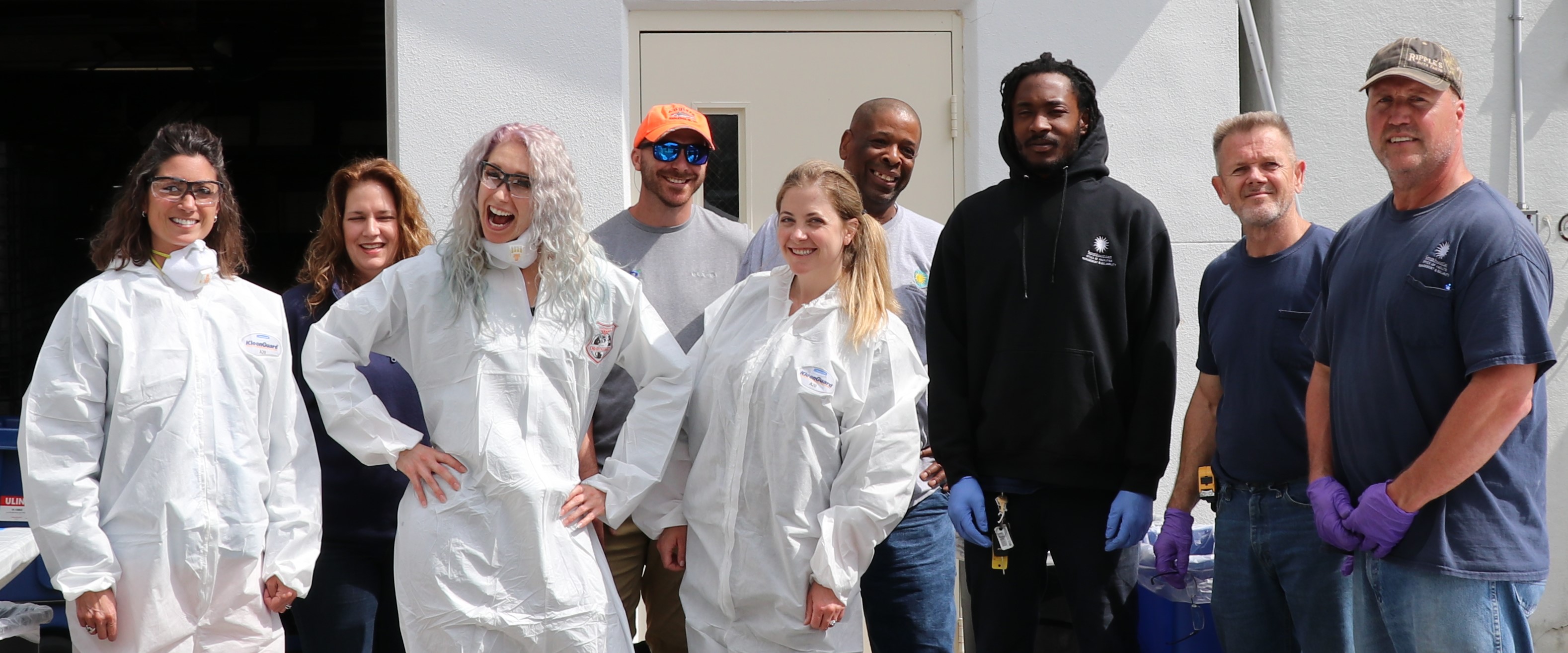
SERC operations and administration staff celebrate finishing the waste audit by posing for a group picture. (Photo: Stephanie Fox/Northwestern University)
Prior to arriving at SERC, Hollinger instructed members of the operations staff to set aside a week’s worth of trash and recycling bags. Because SERC resides in the center of a forest full of inquisitive and hungry critters, the waste was kept in a 45-degree walk-in freezer.
“If you have any compostable material that’s been food contaminated, you can’t leave it out because it’ll either stink or the raccoons will eat it,” said Paul Fitzhugh, SERC’s building and facility manager.
On the day of the October audit, Hollinger and the operations staff weighed each bag, then cut them open to dissect. They placed each item within the bag onto a table to analyze, then sifted through the contents to find items that did not belong. Like a garbage-scented I Spy, they picked recyclable items out of the trash bags and trash out of the recycling bags, sorting the incongruent items into new bins. Once done, they weighed the items found in the wrong bags. That weight was subtracted from the total bag weight to determine the amount of trash or recyclables thrown away incorrectly.
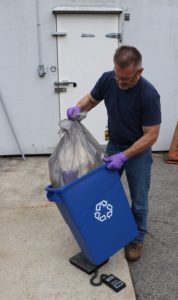
Paul Fitzhugh weighed the recycling bags before opening them to sort. (Photo: Stephanie Fox/Northwestern University)
“We saw that we needed some work out here,” confessed Fitzhugh.
One change was removing the SERC recycling dumpster. Rather than having the Anne Arundel County contractor continue to pick up the recycling and mix it with its other single-stream customers, staff members began driving the recycling to D.C. where it is recycled with other Smithsonian recyclables.
“We justify transporting it because we make that trip every week no matter what,” said Smith. “I have meetings down in D.C., so, it’s not like we’re taking extra trips just to bring the recycling down there.”
Another change was the ordering of color-coded bins to place around campus in February. Landfill items go in a black container, glass and plastics in a green container, and paper in a blue container.
“If it tears like paper, we treat it like paper,” Fitzhugh said. Printer paper, brochures, magazines, even the boxes that hold the scientists’ rubber gloves, can all be recycled in the blue bins.
In March, the operations team also launched an email campaign to educate SERC staff on what items could go in each bin.
The audit on Earth Day was not as thorough as the October audit. Rather than examining a week’s worth of trash and recycling bags, the operations staff and SERC volunteers dissected only a couple of days’ worth of waste. Still, Fitzhugh believes the results will provide a snapshot of the progress made by SERC staff.
“We’re not looking for a massive total. But this is going to give us a good look at our program and how it’s working compared to what we were doing in October,” Fitzhugh said.

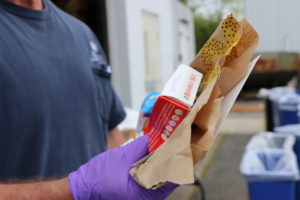

Very impressive! Could the relevant content of the March email campaign (educational part) be made available to volunteers too? Thanks.